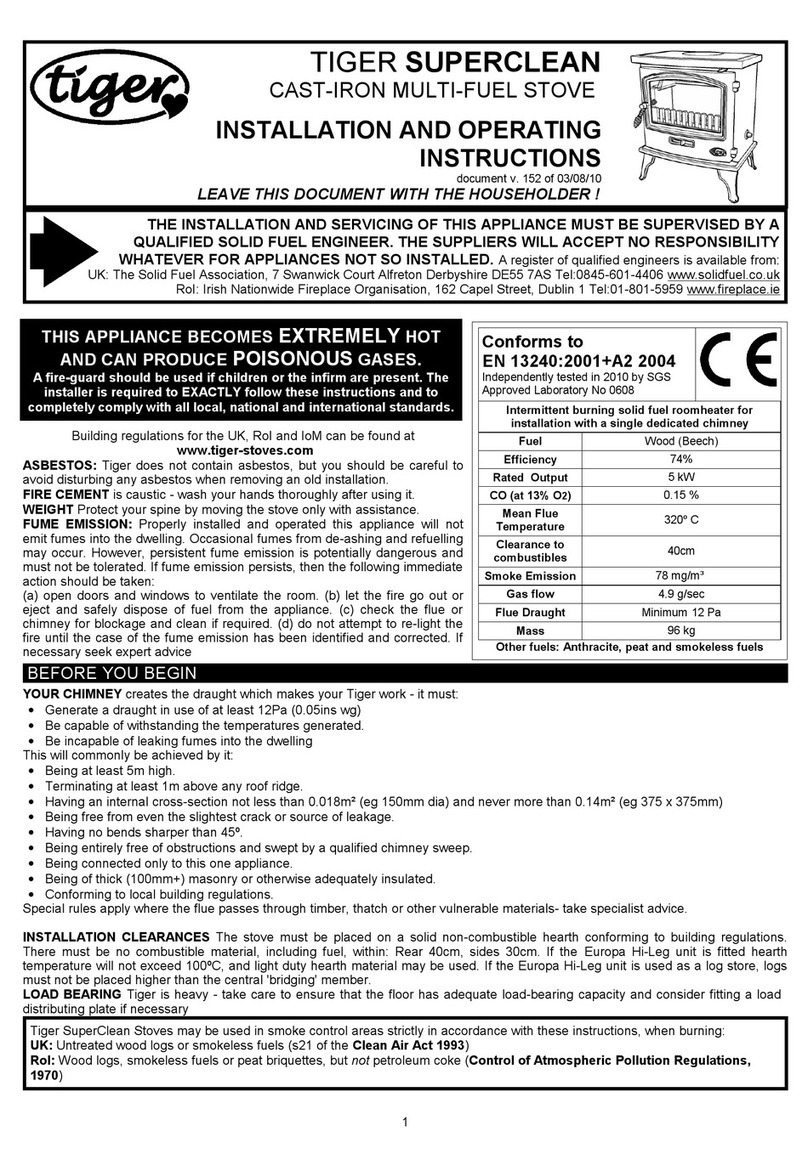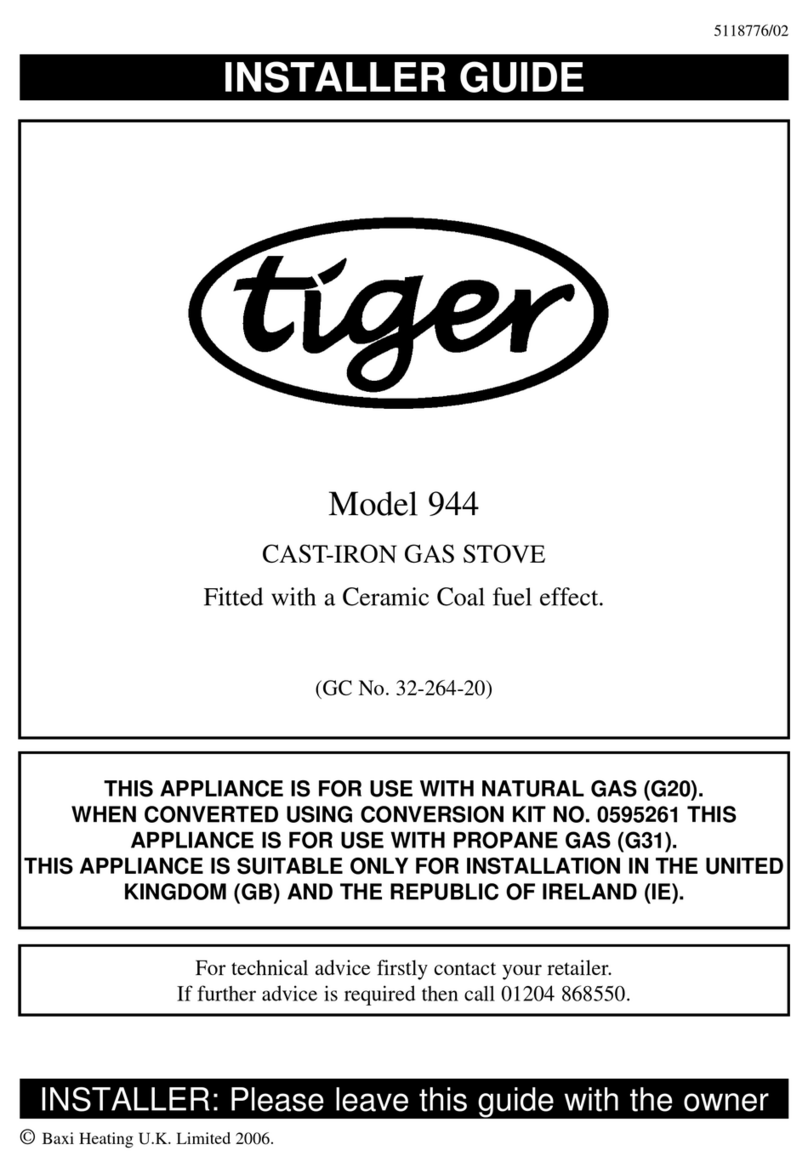flammable, acidic tars which will cling to, and rapidl damage, our
stove and chimne . Split logs will t picall take two ears to become
reasonabl dr , round logs much longer. Cracks in the ends, a
hollow sound when tapped and bark falling awa are all signs that a
log ma be read for use. The fine, white residue produced when
wood burns is not ash, but the remains of cell walls which can burn if
kept hot enough, so don't de-ash a fire until absolutel necessar
when using wood.
For best performance, and alwa s for low smoke emission:
●Split logs lengthwa s for dr ing
●Use logs no bigger than about 100mm x 250mm
●Ensure logs are absolutel dr (less than 20% moisture)
●Fill the Tiger criss-cross, so air can circulate between logs.
●Fill 'little and often'
●When first lighting, or reviving a fire from embers, use onl
ver small, thin, dr , sticks.
●When refuelling, add a log and allow the flames to 'catch' and
begin flaming before full closing the door, then...
●Keep the door firml closed in normal operation.
●Don't overfill the firebox – see the diagram.
JOINERY WASTE Dr wood offcuts will burn well, but don't expect
softwood waste to burn as cleanl or for as long as hardwood logs.
ANTHRA ITE (Smokeless) is a natural hard, shin form of coal.
Slow to light, it can burn for ver long periods with great heat.
Despite its high price-per-bag it generall works out to be one of the
cheapest of all fuels. Use the 'small nuts' size.
PEAT: Like all fuels, needs to be ver , ver dr .
BRIQUETTES Are compressed blocks of fuel. T pes made from
plant materials such as straw or wood waste are ver variable..
Mineral t pes, often in an 'egg' shape, are generall able to burn
with ver little smoke for long periods, but beware of 'econom '
versions which ma contain harmful sulphur.
DO NOT USE... dust materials like sawdust, the burn far to
violentl . Don't use non-authorised 'smokeless fuels' or 'petcoke' -
these are often made with dangerous high-suphur oil waste and will
rapidl damage our Tiger. Don't use raw bituminous coal,
sometimes sold as 'Polish Coal'. These products, though cheap,
rarel represent value for mone .
HOUSEHOLD WASTES Some plastics give off toxic fumes when
burned and remember that batteries and aerosols explode! The
Tiger is definitel not an incinerator, so onl ever use the
recommended fuels and NEVER use liquid fuels in an form.
PROBLEMS
Problems like those listed here are usuall due to some difficult
with the installation, chimne or fuels, so please check back through
this leaflet carefull . If necessar seek specialist advice.
SMOKE FROM THE HIMNEY It is quite normal for a little smoke to
be emitted from the chimne when the fire is cold, so, start the fire
using onl a ver little fuel. Use onl VERY dr fuels.
DAMAGED LINERS Your Tiger gets ver , ver hot inside, it is quite
usual for the replaceable liners to crack or craze. The need onl be
replaced when the have almost completel disintegrated. Help
them last longer b using onl very dry fuel.
POOR HEAT OUTPUT: A stove can heat a t pical room of about
12m³ volume for each kW of output, so a 5kW model can heat up to
(12 x 5) 63m³, a room of about 5m square. The actual size depends
on the insulation, dampness and ventilation of the room. To attempt
to heat a larger room will result in excessive fuel consumption and
damaging overheating.
LA K OF ONTROLLABILITY This stove is designed to alwa s
burn enough to eliminate smoke - adjust the heat output b how
much fuel ou put on, as well as b using the controls.
DIFFI ULTY BURNING FOR EXTENDED PERIODS This stove is
not designed for non-stop burning but for quick heat-up and on-off
use. Longer burning can be achieved onl using ver hard fuels
such as anthracite.
ONDENSATION onto cool surfaces inside the stove can be severe
if fuel is in an wa damp. Use only very dry fuel.
OVER-FIRING: It is possible to leave the fire too long with the
controls set too high leading to 'over firing', seen as glowing metal
parts, excessive chimne temperature and risk of parts failing or
chimne fires. Alwa s set controls to the lowest practical setting.
SMOKE OMING INTO ROOM Fumes are poisonous- smoke
emission must NEVER be tolerated, causes might be:
NEW STOVE: There is often a smell and sometimes visible fumes
as the paint cures. This normall stops after an hour or so.
INADEQUATE SEALS: Are all flue pipes and connectors absolutely
gas-tight? Even the tiniest crack or gap can spoil the draught.
BLOCKED FLUEWAYS: Has soot and ash collected above the inner
back part of the firebox?
UNSUITABLE, BLOCKED OR UN-SWEPT CHIMNEY: The first
requirement for correct operation is a sound chimne . Check the
requirements earlier in this document and in an case of doubt
engage a professional sweep or chimne engineer.
POOR AIR SUPPLY: Lack of air to the fire is a common cause of
smoking and poor performance. Air suppl problems ma be worse
in certain wind conditions (often incorrectl ascribed to
'downdraught', which is in fact ver rare), where air can be sucked
out of the room. The answer is to fit an air vent, as near to the fire as
possible, facing into the usual wind direction.
DOWNDRAUGHT: Wind can blow down a chimne if there is
something higher nearb such as a tree, hill or high building. Fitting
an anti-downdraught cowl to the chimne top can cure this. T pes
which cannot be swept through are not recommended.
POOR CHIMNEY DRAUGHT- Chimne draught in use MUST be at
least 12Pa.
HIMNEY FIRE: In the rare event of deposits inside the chimne
igniting (roaring sound + dense smoke and sparks from the
chimne ) immediatel close the door, shut all air controls and call
the fire brigade. Prevent fires b using very dry fuel and having our
chimne swept regularl .
MAINTENAN E
MONTHLY- LEAN THE INNER
BAFFLE and HE K THE DOOR
SEALS The inner baffle is a metal
plate inside the roof of the Tiger (see
diagram) With the stove cold, lift off
the inspection hatch to remove,
clean and inspect the baffle and
carefull check for blockages.
Check that the door seals are
undamaged, (replacing them if
necessar ) and that the full seal
against the stove bod .
ANNUALLY- SWEEP THE
HIMNEY The entire length of the
chimne from stove to outlet should
be swept annuall b a qualified
chimne sweep.
REFURBISHMENT Should the stove
bod become scratched or dull, repaint it onl with heat resistant
paint supplied for the purpose and onl when the fire is completel
cold.





























